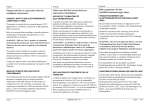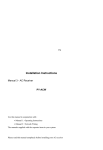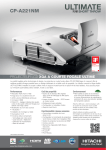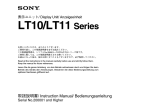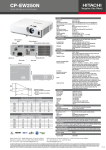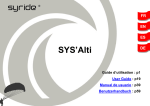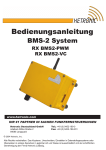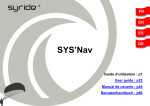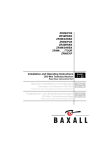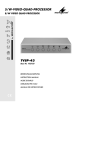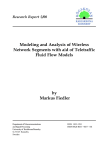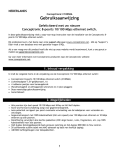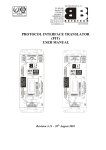Download Please read this in conjunction with the Installation Instructions Cette
Transcript
Deutsch English Français Please read this in conjunction with the Installation Instructions Cette note doit être lue et jointe aux instructions d'installation. Bitte zusammen mit den Installationsanweisungen lesen. SECURITE ET COMPATIBILITE ELECTROMAGNETIQUE PRODUKTSICHERHEIT UND ELEKTROMAGNETISCHE VERTRÄGLICHKEIT (EMV) PRODUCT SAFETY AND ELECTROMAGNETIC COMPATIBILITY (EMC) This product is intended for use in general purpose CCTV applications in a residential, commercial or light industrial EMC environment. Refer to your agent before installing or using the product in medical and/or intrinsically safe applications or in an industrial EMC environment. WARNING : This is a Class A product. In a domestic environment this product may cause radio interference in which case the user may be required to take adequate measures. The product must be installed in accordance with good installation practice to enable the product to function as intended and to prevent problems. Refer to your agent for installation guidance. Contact your agent to obtain a specification defining the acceptable levels of product degradation with regard to EMC immunity. MANUFACTURER’S DECLARATION OF CONFORMANCE The manufacturer declares that the product supplied with this document is compliant with the essential protection requirements of the EMC directive 89/336 and the Low Voltage Directive LVD 73/23 EEC. Conforming to the requirements of standards EN 55022 for emissions, IEC801 parts 2, 3 and 4 for immunity and BS415 superseded by EN60950 for Electrical Equipment safety. Issue 1 Ce produit est destiné à être utilisé pour les applications générales de télévision en circuit fermé dans des environnements résidentiels, commerciaux ou d'industries légères à compatibilité électromagnétique. Dieses Produkt ist für den Einsatz in allgemeinen CCTVAnwendungen in Wohn-, Geschäfts- oder leichtindustriellen Umgebungen ausgelegt. Prendre conseil auprès du revendeur avant d'installer ou utiliser le produit pour des applications médicales et/ou à sécurité intrinsèque ou dans un environnement industriel dans lesquels des précautions doivent être prises dans le domaine des interférences radioélectriques. Wenden Sie sich bitte an Ihre Vertretung, bevor Sie das Produkt in medizinischen und/oder eigensicheren Anwendungen oder in einer industriellen EMV-Umgebung installieren. ATTENTION : Ce produit est rangé en Classe A. Dans un environnement domestique il peut provoquer des interférences radioélectriques. Dans ce cas, l'utilisateur pourra être amené à prendre des mesures appropriées. WARNUNG : Dies ist ein Produkt der Klasse A. In einer Wohnumgebung kann dieses Produkt Funkstörungen verursachen; in diesem Fall wird der Benutzer möglicherweise geeignete Maßnahmen ergreifen müssen. L'installation doit se faire en respectant les règles de l’art afin de permettre le bon fonctionnement du produit et empêcher que d’éventuels problèmes surgissent. Pour obtenir des conseils sur l'installation, s’adresser au revendeur. Das Produkt muß gemäß guten Installationsverfahren installiert werden, damit es vorschriftsmäßig funktionieren kann, und um Probleme zu verhindern. Richtlinien für die Installation erhalten Sie von Ihrer Vertretung. Pour obtenir une spécification définissant les niveaux acceptables de dégradation du produit en relation avec la compatibilité électromagnétique, s’adresser au revendeur. Eine Spezifikation, die das akzeptable Ausmaß der Produktdegradation hinsichtlich EMV-Störfestigkeit festlegt, können Sie von Ihrer Vertretung anfordern. DECLARATION DE CONFORMITE PAR LE FABRICANT Le fabricant déclare que le produit fourni est conforme aux prescriptions de la directive 89/336 sur la compatibilité électromagnétique et de la directive LVD 73/23 sur la basse tension. Il est également conforme aux normes EN 55022 sur les émissions, IEC801 sections 2, 3 et 4 sur la compatibilité et BS415 remplacée par la norme EN60950 relative à la sécurité des équipements électriques. HBEMC/LVD -A-1 KONFORMITÄTSERKLÄRUNG DES HERSTELLERS Der Hersteller erklärt hiermit, daß das mit diesem Handbuch gelieferte Produkt die grundlegenden Schutzanforderungen der EMV-Vorschrift 89/336 und der Niederspannungsverordnung LVD 73/23 EEC erfüllt. Entspricht den Anforderungen der Normen EN 55022 für Emissionen, IEC801, Teil 2, 3 und 4, für Störfestigkeit und BS415, ersetz durch EN60950 für die Sicherheit von Elektrogeräten. Issue 1 : 1/97 ZTX3 ZTX4 Installation and Operating Instructions English ZTX3 and ZTX4 Telemetry Transmitters 1–8 Please read this manual completely before installing your ZTX Manuel d’installationet d’utilisation Français Emetteurs de télémesure ZTX3 et ZTX4 9 – 18 veuillez lire l’ensemble de ces instructions avant de commencer l’installation Installations- und Betriebsanweisungen ZTX3 und ZTX4 Telemetrie-Transmitter Lesen Sie dieses Handbuch bitte ganz durch, bevor Sie Ihren ZTX installieren. Deutsch 19 – 28 This page is intentionally left blank Page 2 For Safety Please read these instructions as you install your ZTX and have them available during the life-time of your ZTX, passing them on to subsequent users. If you have any problems contact your Baxall agent. WARNING : Installation is only to be carried out by competent, qualified and experienced personnel CAUTION : Only use your ZTX with a class 2 power supply. Do not use the power supply provided for any other purpose. Your ZTX is designed for use in general purpose CCTV applications. It must not be used in medical and/or intrinsically safe applications. Do not exceed the voltage and temperature limits given in the specifications. Only use your ZTX in a clean, dry, dust-free environment Electromagnetic Compatibility (EMC) CAUTION : This is a Class A product. In a domestic environment this product may cause radio interference in which case the user may be required to take adequate measures. This product is intended for use in general purpose CCTV applications in a residential, commercial or light industrial EMC environment, refer to your Baxall agent before using the product in an industrial EMC environment. The product must be installed in accordance with good installation practice for EMC to enable the product to function as intended and to prevent EMC problems. Contact your Baxall agent to obtain a specification defining the acceptable levels of product degradation with regard to EMC immunity. MANUFACTURER’S DECLARATION OF CONFORMANCE The manufacturer declares that the ZTX supplied with this manual is compliant with the essential protection requirements of the EMC directive 89/336 and is tested to the requirements of standards EN 55022 for emissions and IEC801 parts 2, 3 and 4 for immunity. The product has been approved in accordance with TCF95/10/02. Unpacking Keep the packaging in case your ZTX needs to be stored for a time or returned for whatever reason. The packaging should contain:• Your ZTX3 or ZTX4 • A socket mounted +12V power supply • These instructions If any of these items is missing or damaged then contact the suppliers and carriers immediately, and do not attempt to use your ZTX. Page 3 Figure 1. A Telemetry System Baxall Telemetry The ZTX3 and ZTX4 are both Baxall telemetry transmitters, this means that they transmit telemetry for reception by a Baxall receiver such as the ZR3-mini or ZR4-mini. Baxall telemetry is for operating a pan and tilt head (P/T head), a lens and auxiliaries by remote control. It comes in two main formats, coaxial and twisted-pair. Figure 1 below shows a typical layout for twisted pair telemetry. Twisted pair telemetry (ZTX4 only) is transmitted on separate wires from the video signal. This is useful for compatibility with free-space transmission systems which are generally not compatible with coaxial telemetry. Baxall coaxial telemetry communicates down the same coaxial cable as the video signal. This has the advantage of only requiring one connection between the camera position and transmitter. Baxall coaxial telemetry comes in two types referred to as old and new. The old coaxial telemetry is asynchronous (not synchronised to the video signal) and can sometimes interfere with on-screen displays (O.S.Ds) such as those produced by multiplexers or time and date generators. To remedy this new coaxial telemetry is synchronised to the video signal. You can switch your ZTX between old and new coaxial telemetry via a switch on a back panel (see figure 2). Unfortunately, new coaxial transmission only works with recent Baxall receivers such as the ZR3-mini and ZR4-mini. Your ZTX is set to old style telemetry as a default. The ZTX3 The ZTX3 has 10 keys, a monitor output BNC, a camera input (telemetry output) BNC, a supplementary earth terminal and a row of switches. The ZTX3 transmits coaxial telemetry. It can control pan, tilt, focus, zoom, and two latching auxiliaries AUX1 (camera power) and AUX3 (auto-pan). The switches on the back panel allow selection of old or new coaxial telemetry and 75 ohm or Hi-Z options on the camera input. You can use the Hi-Z option if you use a T-piece to connect the camera input to another 75 ohm terminated load, such as a monitor or a VCR. Page 4 The ZTX4 The ZTX4 has 15 keys, a monitor output BNC, a camera input (telemetry output) BNC, a 6-pin-mini-din 20mA-twisted-pair connector, a supplementary earth terminal and a row of switches. The ZTX4 can transmit coaxial or twisted pair telemetry. It can control pan, tilt, focus, iris, zoom, four latching auxiliaries AUX1 (Camera power), AUX3 (Auto-pan), AUX5 (Lamps), AUX6 (Wipe) and one momentary auxiliary AUX2 (Wash). The switches on the back panel allow selection of old or new coaxial telemetry and 75 ohm or Hi-Z options on the camera input. The twisted pair connector is a 6-way mini-din socket which carries the current loop output plus an optional link which when made changes the baud rate (speed at which the data is transmitted) from 1200 baud to 300 baud. The slower rate of 300 baud is included to improve reception in electrically noisy environments such as near an electrified railway track. Fitting the 6-pin mini-din plug with pin 3 linked to pin 1 automatically disables the coaxial telemetry and enables 20mA twisted pair telemetry. Associated Equipment Your ZTX can be used in many different configurations. A basic system is shown in figure 1, this basic system includes: • • • • • • • • • • • a monitor a VCR a ZTX transmitter a Baxall telemetry receiver (e.g. a ZR4-mini) a P/T head a CCTV camera (e.g. a Baxall CD9312 colour camera) a motorised lens BNC connectors coaxial cable twisted pair cable associated wiring Figure 1 shows a system using twisted pair telemetry. A similar system using coaxial telemetry would be the same but have all the twisted pair connections removed. Page 5 Connection Standard Connection Connect a 75 ohm video coaxial cable terminated with BNC connectors from your ZTX to your monitor Connect a 75 ohm video coaxial cable terminated with BNC connectors from your ZTX to your receiver (see the receiver instructions.) The default termination for the camera input is 75 ohm. If you want to use the same video signal for another piece of equipment, connect a T-piece to the camera input, de-terminate the input using the switch on the rear panel (select Hi-Z, see figure 2) and ensure that the coaxial cable is 75 ohm terminated somewhere else (e.g. in your VCR or extra monitor). The switch setting for old and new style coaxial telemetry is also shown on figure 2. Figure 2. ZTX Rear Panels Ω Twisted Pair Connection, ZTX4 only Wire up a 6-pin mini-din plug according to figure 3. Link pins 3 (enable) and 1 (GND) to enable twisted-pair telemetry (and automatically disable coaxial telemetry). The default baud rate is 1200 baud. Connect pin 6 (300 baud) to pin 1 (GND) if you want to use 300 baud. Connect the plug to the twisted pair connector and connect the other end to your receiver (see your receiver instructions). Figure 3. The Twisted Pair Socket 1 2 4 3 5 Page 6 6 Operating The ZTX4 key board is shown in figure 4 along with an explanation of the key functions. (The ZTX3 is similar but has fewer keys) Figure 4. ZTX4 Keyboard with explanation of operations The symbols for the auxiliaries are equivalent to older Baxall auxiliaries as follows:Equivalent Symbol AUX number Camera Power AUX 1 Wash AUX 2 Auto-pan AUX 3 Spare AUX 4 Lamps AUX 5 Wipe AUX 6 Page 7 Trouble Shooting Controls Reversed : If left and right, etc. are reversed on your ZTX, this is usually due to incorrect receiver wiring, see the receiver instructions. Picture Tearing : If the picture ‘tears’ at the top when you use a caption generator or multiplexer with built in caption generator. This may be caused by the old style coaxial telemetry. If you have a ZR-mini or more recent receiver then changing to the new style telemetry may remedy this. This places the telemetry information in the blanking period of the video signal instead of continuously across the whole frame. ZTX3 and ZTX4 Specifications All video 1 V pk-pk composite via 75ohm coaxial cable with BNC connectors. Camera input has switchable 75ohm termination. Telemetry Signal ZTX3 and ZTX4 Baxall Coaxial Telemetry. ZTX4 also has 20mA twisted-pair All telemetry is as defined by Baxall Telemetry Specification Control Functions Pan and Tilt, Focus and Zoom (Iris, ZTX4 only) ZTX4 Auxiliaries Latching Auxiliaries with LED indicator AUX 1 (Camera power), AUX 3 (Auto-Pan), AUX 5 (Lamps), AUX 6 (Wipe), Momentary Auxiliary AUX 2 (Wash) ZTX3 Auxiliaries Latching AUX 1 with LED indicator, Latching AUX 3 (Auto-pan) with LED indicator Power Consumption Maximum 2.4 VA Voltage range 12V DC +/-10%. Maximum 150 mA Power Supply Units 230V AC +/-10% to +12V DC +/- 10% (class 2) Dimensions 266 x 88 x 36.5 mm : Weight 0.6 kg : Material ABS endcaps with aluminium and mild steel shell. Colour : Graphite grey, blue lettering and keys Temperature limits Operating -10ºC to +50ºC at 10% to 80% relative humidity (non-condensing) Storage -20ºC to +60ºC at 10% to 95% relative humidity (non-condensing) Page 8 ZTX3 ZTX4 Installation and Operating Instructions English ZTX3 and ZTX4 Telemetry Transmitters 1–8 Please read this manual completely before installing your ZTX Manuel d’installation et d’utilisation Français Emetteurs de télémesure ZTX3 et ZTX4 9 – 18 Veuillez lire l’ensemble de ces instructions avant de commencer l’installation Installations- und Betriebsanweisungen ZTX3 und ZTX4 Telemetrie-Transmitter Lesen Sie dieses Handbuch bitte ganz durch, bevor Sie Ihren ZTX installieren. Deutsch 19 – 28 Cette page été laissée en blanc délibébément Page 10 Sécurité Ces instructions doivent être suivies pendant l’installation du ZTX et être conservées à portée de main pendant toute sa durée de vie et transmises aux utilisateurs ultérieurs. En cas de problèmes, contactez votre agent Baxall. ATTENTION : L’installation doit uniquement être effectuée par un personnel qualifié et expérimenté. ATTENTION : Le ZTX doit uniquement être utilisé avec un transformateur de classe 2. Ne pas utiliser le transformateur fourni avec un autre appareil. Ne pas dépasser les limites de tension et de température indiquées dans les spécifications. Le ZTX doit uniquement être utilisé dans un environnement propre, sec et non poussiéreux. Sécurité et Compatibilitié Electromagnétique Ce produit est destiné à être utilisé pour les applications générales de télévision en circuit fermé dans des environnements résidentiels, commerciaux ou d’industries légères à compatibilité électromagnétique. Prendre conseil auprès de votre agent Baxall avant d’installer ou utiliser le produit pour des applications médicales et/ou à sécurité intrinsèque ou dans un environnement industriel dans lesquels des précautions doivent être prises dans le domaine des interférences radioélectriques. ATTENTION : Ce produit est rangé en Classe A. Dans un environnement domestique il peut provoquer des interférences radioélectriques. Dans ce cas, l’utilisateur pourra être amené à prendre des mesures appropriées. L’installation doit se faire en respectant les règles relatives à la compatibilité électromagnétique afin de permettre le bon fonctionnement du produit et d’empêcher la production d’interférences radioélectriques. Pour obtenir des conseils sur l’installation, contactez votre agent Baxall. Pour obtenir une spécification définissant les niveaux acceptables de dégradation du produit en relation avec la compatibilité électromagnétique, contactez votre agent Baxall. DECLARATION DE CONFORMITE Baxall Security Ltd déclare que le modèle ZTX fourni est conforme aux prescriptions de la directive 89/336 sur la compatibilité électromagnétique et a été testé conformément aux normes EN 55022 sur les émissions et IEC801 sections 2, 3 et 4 sur la compatibilité. Ce produit a obtenu l’homologation TCF95/10/01. Emballage Conserver l’emballage pour entreposer le ZTX dans le cas où il ne devrait pas être utilisé pendant un certain temps ou pour le réexpédier en cas de besoin. L’emballage doit contenir les éléments suivants : • Le ZTX3 ou le ZTX4 • Un transformateur + 12 V • Le manuel Dans le cas où un de ces articles serait manquant ou endommagé, en informer immédiatement le fournisseur et le transporteur et ne pas utiliser l’appareil. Page 11 Système de télémesure Baxall Les ZTX3 et ZTX4 sont des émetteurs qui permettent de transmettre des signaux de télémesure à un récepteur Baxall tel que le ZR3-mini ou le ZR4-mini. Le système de télémesure Baxall permet de commander à distance une caméra à panoramique vertical et horizontal, l’objectif et les fonctions auxiliaires en utilisant un câble coaxial ou un câble à paires torsadées. La Figure 1 ci-dessous correspond à un système typique de télémesure par câble à paires torsadées. Dans ce cas (ZTX4 uniquement), le signal est transmis sur des fils autres que ceux du signal vidéo pour une plus grande compatibilité avec les systèmes de transmission en espace libre qui ne sont généralement pas compatibles avec la télémesure transmise par câble coaxial. Figure 1. Système de télémesure Les signaux de télémesure Baxall par câble coaxial passent par le même câble que le signal vidéo. Cette solution a pour avantage de ne faire appel qu’à une seule connexion entre la caméra et l’émetteur. Le système de télémesure Baxall par câble coaxial se présente sous deux types différents. L’ancien système est asynchrone (non synchronisé avec le signal vidéo) et peut parfois interférer avec des affichages tels que ceux produits par des multiplexeurs ou des générateurs d’heure ou de date. Pour remédier à ce problème, ce nouveaux système de télémesure par câble coaxial est synchronisé avec le signal vidéo. Il est possible de basculer le ZTX entre l’ancien et le nouveau système de télémesure grâce à un commutateur situé sur le panneau arrière (voir Figure 2). Malheureusement, le nouveau système de transmission par câble coaxial fonctionne uniquement avec les récepteurs Baxall les plus récents, c’est-à-dire les ZR3-mini et ZR4-mini. Le ZTX est réglé par défaut pour l’ancien système de télémesure. Page 12 Le ZTX3 Le ZTX3 dispose de 10 touches, une sortie écran BNC, une entrée caméra BNC (sortie télémesure), une borne supplémentaire de mise à la terre et un commutateur DIP. Le ZTX3 émet des signaux de télémesure sur câble coaxial. Il permet de contrôler le panoramique horizontal et vertical, la mise au point, le zoom et deux fonctions auxiliaires verrouillées AUX1 (alimentation de la caméra) et AUX3 (panoramique automatique). Le commutateur DIP situé sur le panneau arrière permet de passer de l’ancien au nouveau système de télémesure et de choisir entre 75 ohms et Hi-Z pour l’entrée de la caméra. L’option Hi-Z doit être choisie lorsqu’une connexion en T est utilisée pour connecter l’entrée de la caméra avec un autre appareil sur une ligne en 75 ohms tel qu’un écran ou un magnétoscope. Le ZTX4 Le ZTX4 dispose de 15 touches, une sortie écran BNC, une entrée caméra BNC (sortie télémesure), un connecteur pour câble à paires torsadées de 20 mA (une douille miniature DIN à 6 contacts), une borne supplémentaire de mise à la terre et un commutateur DIP. Le ZTX4 peut transmettre un signal de télémesure par câble coaxial ou à paires torsadées. Il permet de commander le panoramique vertical et horizontal, la mise au point, le diaphragme, le zoom, 4 fonctions auxiliaires verrouillées AUX1 (alimentation caméra), AUX3 (panoramique automatique), AUX5 (lampes), AUX6 (essuie-glace) et une fonction momentanée AUX2 (lave-glace). Le commutateur DIP situé sur le panneau arrière permet de passer de l’ancien système de télémesure au nouveau et de choisir entre les options 75 ohms et Hi-Z pour l’entrée de la caméra. Le branchement du câble à paires torsadées se fait par une douille miniature DIN à 6 contacts qui supporte la sortie courant de boucle plus une liaison optionnelle qui permet de changer la rapidité de modulation (vitesse à laquelle les données sont transmises) de 1200 bauds à 300 bauds. La vitesse la plus faible de 300 bauds a été prévue pour améliorer la réception dans les environnements très parasités, comme par exemple à proximité d’une voie de chemin de fer. En reliant la broche 3 à la broche 1 d’une fiche miniature DIN, la transmission du signal de télémesure par câble coaxial est désactivée au profit de la transmission par câble à paires torsadées de 20 mA. Page 13 Equipement associé Le ZTX peut être utilisé dans différentes configurations. Un système de base est indiqué Figure 1 et comprend : • • • • • • • • • • • écran magnétoscope émetteur ZTX récepteur de télémesure Baxall (par exemple ZR4-mini) unité à panoramique vertical et horizontal caméra (par exemple caméra couleur Baxall CD9312) objectif motorisé connecteurs BNC câble coaxial câble à paires torsadées câblage associé La Figure 1 correspond à un système utilisant le câble à paires torsadées. Un système similaire utilisant la transmission par câble coaxial serait identique mais toutes les connexions par paires torsadées seraient supprimées. Connexions Connexions standard Brancher un câble vidéo coaxial de 75 ohms terminé par des fiches BNC entre le ZTX et l’écran. Brancher un câble vidéo coaxial de 75 ohms terminé par des fiches BNC entre le ZTX et le récepteur (se reporter aux instructions du récepteur). Le réglage par défaut pour l’entrée de la caméra est 75 ohms. Pour utiliser le même signal vidéo pour un autre appareil, brancher une connexion en T sur l’entrée de la caméra, modifier l’entrée en utilisant le commutateur DIP (sélectionner Hi-Z, voir Figure 2) et vérifier que le câble coaxial aboutit ailleurs à une charge de 75 ohms (par exemple le magnétoscope ou un écran supplémentaire). Figure 2. Panneau arrière du ZTX Le réglage du commutateur DIP pour l’ancien et le nouveau systèmes de télémesure est indiqué Figure 2. Page 14 Câble à paires torsadées, ZTX4 uniquement Câbler une fiche miniature DIN à 6 broches en se référant à la Figure 3. Relier les broches 3 (validation) et 1 (terre) pour permettre l’envoi du signal du télémesure par paires torsadées et désactiver automatiquement celui par câble coaxial. La rapidité de modulation par défaut est 1200 bauds. Relier la broche 6 (300 bauds) à la broche 1 (terre) pour utiliser du 300 bauds. Brancher la fiche sur le connecteur pour câble à paires torsadées et l’autre extrémité sur le récepteur (se reporter aux instructions du récepteur). Figure 3. Douille pour câble à paires torsadées 1 2 4 3 5 6 Utilisation Les touches du ZTX4 sont indiquées Figure 4 avec la légende des fonctions correspondantes (la ZTX3 est similaire mais possède moins de touches). Figure 4. Touches et fonctions correspondantes du ZTX4 Page 15 Les symboles des auxiliaires sont équivalents à ceux des systèmes Baxall plus anciens et sont : Equivalent Symbol Auxiliaire Alimentation caméra AUX 1 Lave-glace AUX 2 Panoramique auto AUX 3 Non utilisé AUX 4 Lampes AUX 5 Essuie-glace AUX 6 Localisation des pannes Inversion des commandes : Lorsque la gauche et la droite, etc. sont inversées sur le ZTX, la cause en est généralement un mauvais câblage du récepteur (se reporter aux instructions du récepteur). Déchirure de l’image : Lorsque l’image se déchire en haut pendant l’utilisation d’un générateur de titres ou d’un multiplexeur avec générateur de titres incorporé, il peut s’agir d’un problème lié à la transmission du signal de télémesure par l’ancien système. Dans le cas où un ZR-mini ou un récepteur plus récent est utilisé, il suffit alors de passer au nouveau type de transmission pour remédier au problème et dans ce cas, le signal de télémesure est placé dans l’intervalle de suppression du signal vidéo au lieu d’être transmis en continu. Page 16 Spécifications - ZTX3 et ZTX4 Signal vidéo Signal vidéo composite de 1 V crête à crête via câble coaxial de 75 ohms avec connecteurs BNC. L’entrée caméra est commutable en 75 ohms. Signal de télémesure ZTX3 et ZTX4 : système Baxall de télémesure par câble coaxial. Le ZTX4 peut également émettre sur câble à paires torsadées de 20 mA. Tous les systèmes répondent à la spécification Baxall sur la télémesure. Fonctions Panoramique horizontal/vertical, mise au point et zoom (diaphragme sur le ZTX4 uniquement). Fonctions auxiliaires ZTX4 Fonctions verrouillées avec diodes indicatrices : AUX1 (alimentation caméra), AUX3 (panoramique automatique), AUX5 (lampes), AUX6 (essuie-glace). Fonction momentanée : AUX2 (lave-glace). Fonctions auxiliaires ZTX3 Fonctions verrouillées avec diodes indicatrices : AUX1 (alimentation caméra), AUX3 (panoramique automatique). Consommation Maximum 2,4 VA. Alimentation 12 V cc ± 10 %. Maximum 150 mA. Transformateur 230 V ca ± 10 % en 12 V cc ± 10 % (classe 2). Dimensions 266 mm x 88 mm x 36,5 mm. Poids : 0,6 kg. En aluminium et acier doux avec extrémités en ABS. Gris anthracite avec lettres et touches bleues. Plage de températures Limites de température d’utilisation : - 10°C à + 50°C pour un taux d’humidité relative de 10 % à 80 % (sans condensation) Limites de température de stockage : - 20°C à + 60°C pour un taux d’humidité relative de 10 % à 95 % (sans condensation) Page 17 Cette page été laissée en blanc délibébément Page 18 ZTX3 ZTX4 Installation and Operating Instructions English ZTX3 and ZTX4 Telemetry Transmitters 1–8 Please read this manual completely before installing your ZTX Manuel d’installation et d’utilisation Français Emetteurs de télémesure ZTX3 et ZTX4 9 – 18 Veuillez lire l’ensemble de ces instructions avant de commencer l’installation Installations- und Betriebsanweisungen ZTX3 und ZTX4 Telemetrie-Transmitter Lesen Sie dieses Handbuch bitte ganz durch, bevor Sie Ihren ZTX installieren. Deutsch 19 – 28 Diese Seite ist absichtlich leer gelassen worden Page 20 Zur Sicherheit Befolgen Sie diese Anweisungen bitte bei der Installation Ihres ZTX, heben Sie sie anschließend solange auf, wie Ihr ZTX in Gebrauch ist, und geben Sie sie an zukünftige Besitzer weiter. WARNUNG: Die Installation darf nur von fachkundigem, qualifizierten und erfahrenen Personal ausgeführt werden. VORSICHT: Ihr ZTX darf nur mit einer Stromversorgung der Klasse 2 benutzt werden. Die zur Verfügung gestellte Stromversorgung darf für keinen anderen Zweck benutzt werden. Die in den Spezifikationen angegebenen Spannungswerte und Temperaturgrenzen dürfen nicht überschritten werden. Den ZTX nur in sauberen, trockenen und staubfreien Umgebungen benutzen. Produktsicherheit und Elektromagnetische Verträglichkeit Dieses Produkt ist für den Einsatz in allgemeinen CCTV-Anwendungen in Wohn-, Geschäftsoder leichtindustriellen Umgebungen ausgelegt. Wenden Sie sich bitte an Ihrem Fachhändler, bevor Sie das Produkt in medizinischen und/oder eigensicheren Anwendungen oder in einer industriellen EMV-Umgebung installieren. WARNUNG : Dies ist ein Produkt der Klasse A. In einer Wohnumgebung kann dieses Produkt Funkstörungen verursachen; in diesem Fall wird der Benutzer möglicherweise geeignete Maßnahmen ergreifen müssen. Das Produkt muß gemäß guten Installationsverfahren für EMV installiert werden, damit es vorschriftsmäßig funktionieren kann, und um EMV-Probleme zu verhindern. Richtlinien für die Installation erhalten Sie von Ihrem Fachhändler. Eine Spezifikation, die das akzeptable Ausmaß der Produktdegradation hinsichtlich EMV-Störfestigkeit festlegt, können Sie von der Technischen Abteilung von Ihrem Fachhändler anfordern. KONFORMITÄTSERKLÄRUNG DES HERSTELLERS Baxall Security Ltd erklärt hiermit, daß das mit diesem Handbuch gelieferte ZTX-Modell den grundlegenden Sicherheitsanforderungen der EMV-Direktive 89/336 entspricht und gemäß den Anforderungen der Normen EN 55022 für Emissionen und IEC801 Teil 2, 3 und 4 für Störfestigkeit geprüft worden ist. Das Produkt ist zugelassen gemäß TCF95/10/01. Auspacken Bewahren Sie die Verpackung auf, für den Fall, daß Sie Ihren ZTX eine zeitlang lagern oder aus irgendeinem Grund zurückschicken möchten. Die Verpackung sollte folgendes enthalten: • Ihren ZTX3 oder ZTX4 • Eine Steckdosen-montierte +12 Volt Stromversorgung • Diese Anweisungen Wenn einer dieser Posten fehlt oder beschädigt ist, informieren Sie bitte umgehend den Lieferanten und den Spediteur, und versuchen Sie nicht, Ihren ZTX zu benutzen. Page 21 Baxall Telemetrie Sowohl der ZTX3 als auch der ZTX4 sind Baxall Telemetrie-Transmitter; das bedeutet, daß Sie Telemetrie für den Empfang durch einen Baxall Empfänger, wie z.B. den ZR3-mini oder den ZR4-mini übertragen. Baxall Telemetrie ermöglicht es, einen Schwenk- und Neigungskopfes (S/N-Kopf, ein Objektivs und Zubehörgeräte durch Fernsteuerung zu betreiben. Er ist in zwei Formaten erhältlich - koaxial oder mit verdrillten Doppelleitungen. Abbildung 1 zeigt eine typische Anordnung für Telemetrie mit verdrillten Doppelleitungen. Bei Telemetrie mit verdrillten Doppelleitungen (nur ZTX4) wird diese über vom Videosignal separate Leitungen übertragen. Dies ist für die Kompatibilität bei Freiraumübertragungssystemen nützlich, die normalerweise nicht mit Koax-Telemetrie kompatibel sind. Abbildung 1. Ein Telemetriesystem Baxalls koaxiale Telemetrie überträgt über dasselbe Koaxkabel wie das Videosignal. Dies hat den Vorteil, daß nur eine Verbindung zwischen der Kameraposition und dem Transmitter erforderlich ist. Baxalls koaxiale Telemetrie gibt es in zwei Ausführungen, die als die alte und die neue bezeichnet werden. Die alte koaxiale Telemetrie ist asynchron (nicht mit dem Videosignal synchronisiert) und kann manchmal die Bildschirmanzeigen (O.S.D.s On-Screen-Displays) stören, wie z.B. die, die von den Multiplexern oder von den Zeit- und Datumgeneratoren produziert werden. Um dies zu verhindern, ist die neue koaxiale Telemetrie mit dem Videosignal synchronisiert. Sie können Ihren ZTX mit einem Schalter an der Rücktafel (siehe Abbildung 2) zwischen der alten und neuen koaxialen Telemetrie hin- und herschalten. Leider funktioniert die neue koaxiale Übertragung nur bei neueren Baxall Empfängern wie ZR3-mini oder ZR4-mini. Ihr ZTX ist als Normaleinstellung auf die alte Telemetrie eingestellt. Page 22 Der ZTX3 Der ZTX3 hat 10 Tasten, einen Monitorausgang BNC, einen Kameraeingang (Telemetrie-Ausgang) BNC, einen zusätzlichen Erdabschluß und eine Reihe von Schaltern. Der ZTX3 überträgt koaxiale Telemetrie. Er kann Schwenkung, Neigung, Fokus, Zoom und zwei verriegelnde Hilfsfunktionen AUX1 (Kamerastrom) und AUX3 (automatische Schwenkung) steuern. Die Schalter an der Rücktafel ermöglichen die Wahl der alten oder neuen koaxialen Telemetrie und 75 Ohm oder Hi-Z Optionen am Kameraeingang. Sie können die Hi-Z-Option benutzen, wenn Sie ein T-Stück benutzen, um den Kameraeingang an eine andere mit 75 Ohm abgeschlossene Last anzuschließen, wie z.B. einen Monitor oder einen VCR. Der ZTX4 Der ZTX4 hat 15 Tasten, einen Monitorausgang BNC, einen Kameraeingang (Telemetrieausgang) BNC, eine 6-stiftige Mini-DIN 20mA Steckverbindung für verdrillte Doppelleitung, einen zusätzlichen Erdabschluß und eine Reihe von Schaltern. Der ZTX4 kann koaxiale Telemetrie oder Telemetrie über verdrillte Doppelleitung übertragen. Er kann Schwenkung, Neigung, Fokus, Blende, Zoom, vier verriegelnde Hilfsfunktionen AUX1 (Kamerastrom), AUX3 (automatische Schwenkung), AUX5 (Lampen), AUX6 (Wischen) und eine momentane Hilfsfunktion AUX2 (Waschen) steuern. Die Schalter an der Rücktafel ermöglichen die Wahl der alten oder neuen koaxialen Telemetrie und 75 Ohm oder Hi-Z Option am Kameraeingang. Die Steckverbindung der verdrillten Doppelleitung ist eine 6-wegige Mini-DIN-Buchse, die den gegenwärtigen Schleifenausgang plus eine wahlweise Verbindung führt, die wenn sie hergestellt wird, den Baud-Wert (Datenübermittlungs-Geschwindigkeit) von 1200 Baud auf 300 Baud ändert. Die niedrigere Geschwindigkeit von 300 Baud wird geboten, um den Empfang in Umgebungen mit starken elektrischen Störgeräuschen, wie z.B. in der Nähe einer elektrifizierten Bahnstrecke, zu verbessern. Wenn der 6-stiftige Mini-DIN-Stecker so installiert wird, daß Stift 3 mit Stift 1 verbunden ist, wird dies die koaxiale Telemetrie automatisch sperren und die 20mA Telemetrie mit verdrillter Doppelleitung freigeben. Page 23 Dazugehörige Ausstattung Ihr ZTX kann in vielen verschiedenen Konfigurationen benutzt werden. Ein einfaches System ist auf Abbildung 1 dargestellt und enthält: • • • • • • • • • • • einen Monitor einen VCR einen ZTX-Transmitter einen Baxall Telemetrie-Empfänger (z.B. einen ZR4-mini) einen S/N-Kopf eine CCTV-Kamera (z.B. eine Baxall CD9312 Farbkamera) ein Objektiv mit Motorantrieb BNC-Steckverbindungen Koaxkabel verdrillte Doppelleitung dazugehörige Verdrahtung Abbildung 1 zeigt ein System für Telemetrie mit verdrillter Doppelleitung. Ein entsprechendes System mit Koax-Telemetrie würde genauso aussehen, außer daß alle Steckverbindungen der verdrillten Doppelleitung fehlen würden. Anschluß Standardmäßiger Anschluß Ein 75 Ohm Video-Koaxkabel mit BNC-Steckverbindungsabschluß vom ZTX an Ihren Monitor anschließen. Ein 75 Ohm Video-Koaxkabel mit BNC-Steckverbindungsabschluß vom ZTX an Ihren Empfänger anschließen (siehe Empfänger-Anweisungen). Die Normaleinstellung für den Abschluß des Kameraeingangs ist 75 Ohm. Wenn Sie dasselbe Videosignal für ein anderes Gerät benutzen möchten, wird ein T-Stück an den Kameraeingang angeschlossen, und der Abschluß des Eingangs wird mit Hilfe des Schalters an der Rücktafel getrennt (Hi-Z wählen, siehe Abbildung 2), wobei sicherzustellen ist, daß das Koaxkabel an anderer Stelle mit 75 Ohm Abschluß versehen wird (z.B. an Ihrem VCR oder zusätzlichen Monitor). Abbildung 2. ZTX Rücktafel Die Schalterstellung für alte und neue koaxiale Telemetrie ist auch auf Abbildung 2 dargestellt. Page 24 Anschluß mit verdrillter Doppelleitung, nur ZTX4 Einen 6-stiftigen Mini-DIN-Stecker wie auf Abbildung 3 dargestellt verdrahten. Stifte 3 (Freigabe) und 1 (ERDE) verbinden, um Telemetrie über verdrillte Doppelleitung zu erhalten (und automatisch Koax-Telemetrie zu sperren). Die Normaleinstellung des Baud-Werts ist 1200 Baud. Wenn Sie 300 Baud benutzen möchten, wird Stift 6 (300 Baud) an Stift 1 (ERDE) angeschlossen. Den Stecker an die Steckverbindung der verdrillten Doppelleitung anschließen und das andere Ende an Ihren Empfänger anschließen (siehe Anweisungen für Ihren Empfänger). 1 2 4 3 5 6 Abbildung 3. Buchse für verdrillte Doppelleitung Betrieb Das ZTX-4 Tastenfeld und eine Erklärung der Tastenfunktionen ist auf Abbildung 4 gezeigt. (Der ZTX3 ist ähnlich, hat aber weniger Tasten). Abbildung 4. ZTX4 Tastenfeld mit Bedienungserläuterung Page 25 Die Symbole für die Hilfsfunktionen entsprechen den älteren Baxall Hilfsfunktionen wie folgt: Entsprechung Symbol Hilfsfunktion-Nr. Kamerastrom AUX 1 Waschen AUX 2 Automatisches Schwenken AUX 3 Nicht belegt AUX 4 Lampen AUX 5 Wischen AUX 6 Fehlersuche Bedienungselemente verkehrt: Wenn links und rechts, usw. an Ihrem ZTX vertauscht sind, liegt dies meistens an falscher Empfängerverdrahtung; siehe Empfänger-Anweisungen. Bildriß: Wenn das Bild oben “reißt”, wenn Sie einen Unterschriftenerzeuger oder Multiplexer mit eingebautem Unterschriftenerzeuger benutzen. Dies kann durch die ältere koaxiale Telemetrie verursacht werden. Wenn Sie einen ZR-mini oder einen neueren Empfänger haben, kann Umwechseln auf die neue Telemetrieart dies beheben. Diese positioniert die Telemetrieinformation in den Zeilenlöschperioden des Videosignals statt kontinuierlich über das ganze Bild. Page 26 ZTX3 und ZTX4 Spezifikationen Alle Videos 1V Spitze-Spitze zusammengesetztes Signal über 75 Ohm Koaxkabel mit BNC-Stecker. Kameraeingang hat schaltbaren 75 Ohm Abschluß. Telemetrie-Signal ZTX3 und ZTX4 Baxall Koax-Telemetrie. ZTX4 bietet außerdem 20mA Übertragung über verdrillte Doppelleitung. Alle Telemetrie wird in Baxalls Telemetrie-Spezifikation definiert. Steuerfunktionen Schwenken und Neigen, Fokus und Zoom (Blende nur bei ZTX4) ZTX4 Hilfsfunktionen Verriegelnde Hilfsfunktionen mit LED-Anzeige AUX1 (Kamerastrom), AUX3 (automatisches Schwenken), AUX5 (Lampen), AUX6 (Wischen), momentane Hilfsfunktion AUX2 (Waschen). ZTX3 Hilfsfunktionen Verriegelnde AUX1 mit LED-Anzeige, verriegelnde AUX3 (automatisches Schwenken) mit LED-Anzeige Stromverbrauch Max. 2,4 VA. Spannungsbereich 12V Gleichstrom +/- 10%. Max. 150 mA. Stromversorgungsgeräte 230 V Wechselstrom +/- 10% auf 12 V Gleichstrom +/- 10% (Klasse 2) Abmessungen 266 x 88 x 36,5mm; Gewicht 0,6kg; Material: ABS Endkappen mit Aluminum- und Weichstahlgehäuse. Farbe: Graphitgrau, blaue Beschriftung und Tasten. Temperaturgrenzen Betriebstemperaturgrenzen: -10°C bis +50°C bei 10% bis 80% relativer Feuchtigkeit (nicht kondensierend) Lagertemperaturgrenzen: -20°C bis +60°C bei 10% bis 95% relativer Feuchtigkeit (nicht kondensierend) Page 27 Baxall Security Limited Stockport, England. Baxall Security Ltd. Reserve the right to make changes to the product and specification of the product from time to time without prior notice to the customer. Baxall Security Ltd. réserve le droit de modifier ses produits et leurs spécifications sans avis préalable. Baxall Security Ltd. behält sich das Recht vor, Produkte und Spezifikationen ohne vorherige Ankündigung an Kunden zu ändern. Edition 1 : 2/96 HBZTX34/E






























